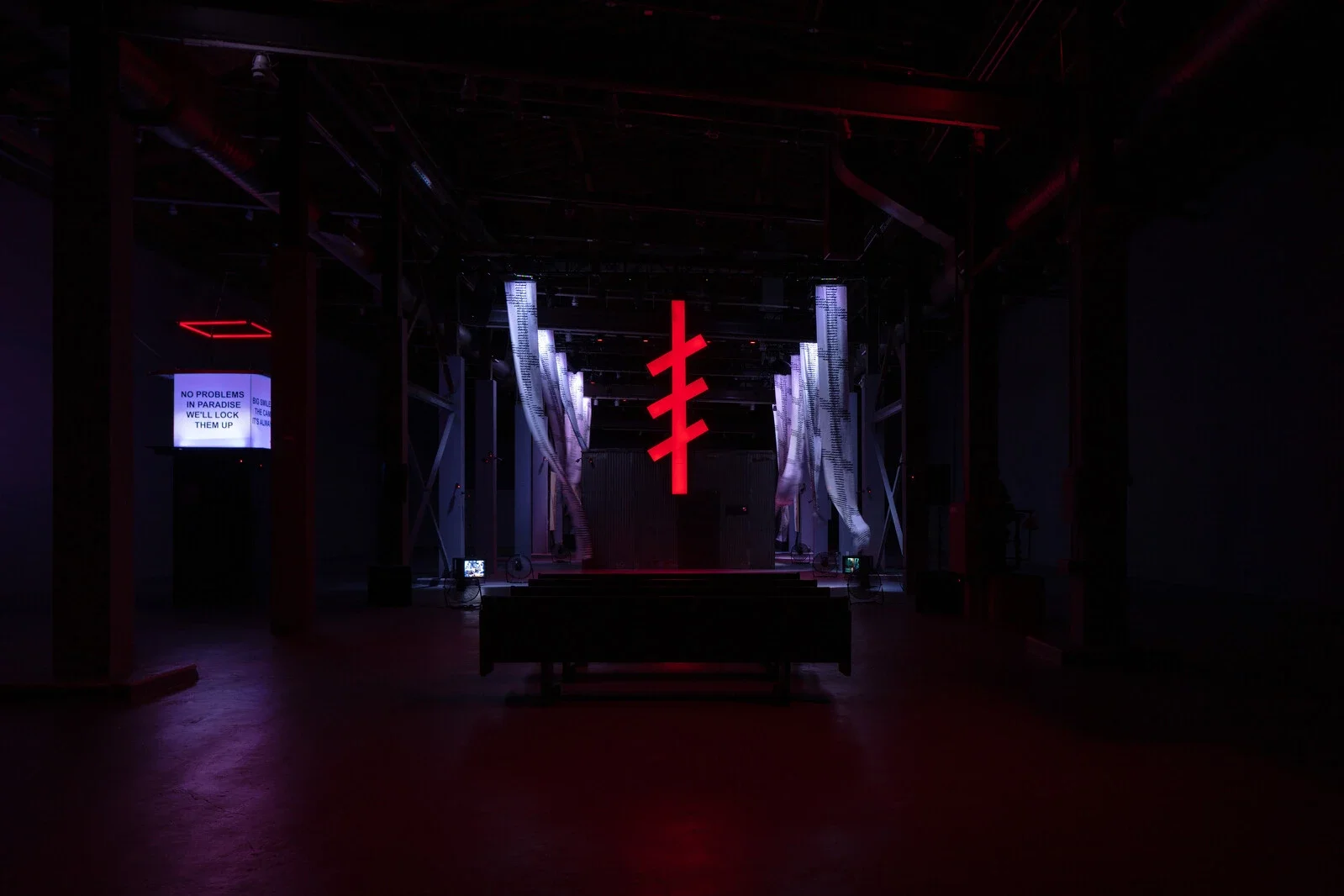EMBODIED DISSENT
Nadya Tolokonnikova, Police State (2025).
Upon entering her mock prison cell, Nadya Tolokonnikova let out a guttural shriek. Her voice reverberated through the installation, layered with eerie lullabies, climaxing into harsh bursts of noise. Occupying the central cell, Tolokonnikova was dimly lit by neon light, adorned in a forest green Adidas jumpsuit. Visitors were prompted to inspect and surveil the scene. Bed sheets made by American and Belarusian prisoners lined the walls, as the space came under each character's gaze. The performance, Police State (2025), bore a tension between prison and sanctuary.
Tolokonnikova is an artist, activist, and founder of Pussy Riot; a Russian performance group founded in 2011. Pussy Riot has relentlessly exposed Russia’s government corruption. In 2012, Tolokonnikova was incarcerated for an anti-Putin, balaclava performance at a Moscow Orthodox Cathedral, titled Punk Prayer. During her imprisonment, she went on three hunger strikes and published an open letter describing “slavery-like conditions”. In 2023, Tolokonnikova’s installation, Putin’s Ashes, at Jeffrey Deitch Gallery in Los Angeles, landed her on the Russian most-wanted criminal list. Tolokonnikova has since lived in exile, moving around perpetually without disclosing her location. From June 5th to 21st, 2025, Tolokonnikova was subjected to another type of surveillance — a jail of her own making, Police State. At the Museum of Contemporary Art in Los Angeles (MOCA), Tolokonnikova existed in a corrugated steel replica of her Russian prison cell.
Untethered to materiality, Police State defied convention. The oeuvre of performance art is composed of audience and artist actions. Without a physical product, performance art is not marketable. In 2016, theorist Jonah Westerman remarked, “performance is not (and never was) a medium, not something that an artwork can be but rather a set of questions and concerns about how art relates to people and the wider social world.” Thus, Police State was a site where the observers and the observed existed in a perpetual dance of oppression and resistance. The effect was a critique of autocratic surveillance.
The audience was embedded within Police State. Visitors pressed close to the steel cage, where large slits allowed a glimpse of Tolokonnikova. Others examined her through a security camera, replicating autocratic CV surveillance. In either case, they were implicated in the surveillance — a dynamic that would have been further heightened if Tolokonnikova could have realised her plan (discarded for liability reasons) to build watchtowers for visitors, literally placing them in the hyper-vigilant prison guard position. The audience was confronted by their own voyeurism.
Ordinarily, we are inundated by passive imagery upon entering a gallery. We can easily glaze over meek abstractions and crowd-pleasing landscapes. Commercial galleries’ collections fold into minimalist interiors, lulling us into passive states of low-impact consumption to maximise profit. The bureaucratisation of public galleries’ stifle their objectivity. Contrarily, Police State necessitates a reciprocal exchange between the viewer and the performer, which Walter Benjamin defined as “aura”: the integral essence of an original work that fades in reproduction. Witnesses observed Tolokonnikova’s proceedings, outside of reproduction as only existing in the present, then becoming memory. The in-person viewership reacquainted the audience with the auratic details of Police State, before it wilted. It denied the audience passivity.
The performance’s backdrop made Police State’s urgency particularly poignant. On the fourth day of Police State, a police stampede penetrated the installation space. Police helicopters hovered overhead the sprawling Los Angeles streets. An officer delivered an order to disperse through a loudspeaker. Donald Trump had instigated a clash between U.S. Immigration and Customs Enforcement agents, members of the California National Guard and anti-immigration protesters. MOCA was closed, barring audience observation. Tolokonnikova continued her performance in the empty museum, posting on Instagram: “Police State exhibit closed today due to police state.”
Nadya Tolokonnikova, Police State (2025).
“I felt I had entered a wormhole,” Tolokonnikova recalled following the 2025 L.A. riots. The parallels between Police State’s closure and Tolokonnikova’s first arrest are sinister at best. For the final duration of the performance, rather than show prison recordings, she live-streamed audio of the protests outside into the mock cell. The present penetrated Police State, which was initially a reckoning with Tolokonnikova’s past. Autocracy protrudes in both scenes.
America has feigned values such as freedom and democracy; thus, for privileged white Americans, the idea of living in an autocratic society was previously inconceivable. However, as Tolokonnikova quipped, “authoritarianism is like a sexually transmitted disease — you have it before you know it.” And suppose we understand authoritarianism as the rule of a single party or leader that deems itself infallible, the Trump administration meets the criteria. With a totalitarian thrust, Trump began his presidency by stripping art centres and universities of funding. Pervasive immigration reforms have prompted mass expulsion. Reproductive rights have regressed. The transgender identity remains precarious. Compromised bodily autonomy has made performance art pertinent.
The performance genre makes a lasting impression beyond cursory engagement. Police State (2025) viscerally alerted its audience to the resemblance between Russian and American autocratic tactics, when most artistic mediums fall short. The piece immersed viewers in a critical fabulation, and rendered palpable the artist’s lived imprisonment. Tolokonnikova has earned our attention.
Designed by Portia Love




